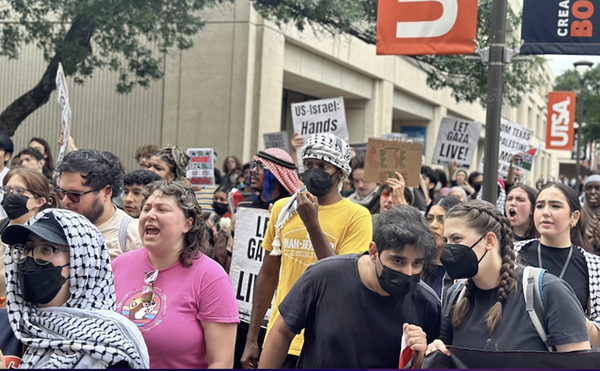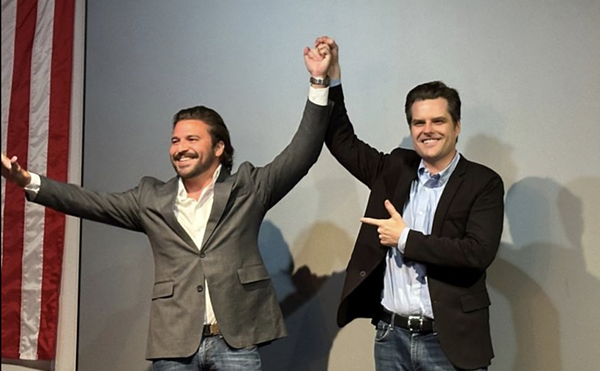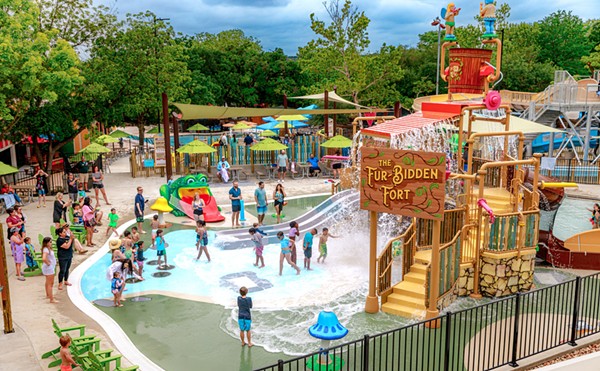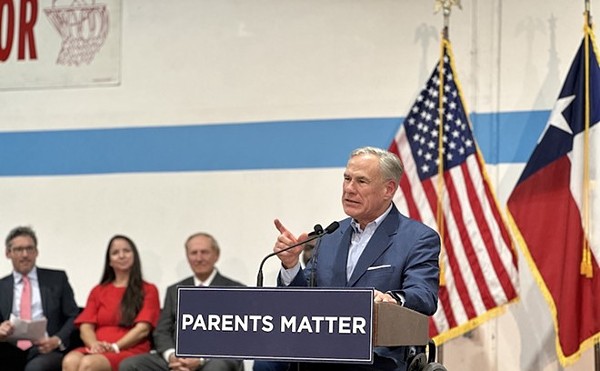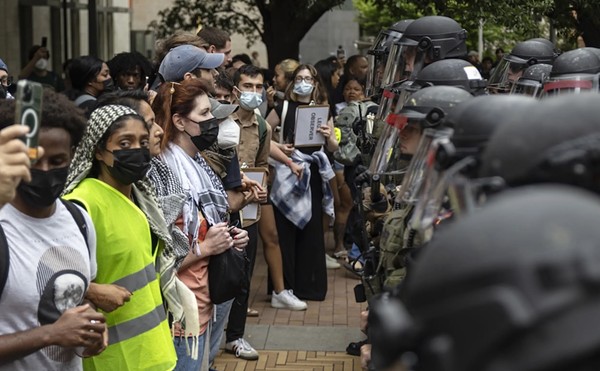
Before I moved to San Antonio, the little I gleaned of her citizens’ politics inked an indelible blue portrait in my mind. At the time, I was covering protests of an immigrant detention center located north of Austin and the largest, most passionate contingent of protestors drove up frequently from SA.
Upon moving here, some of my first assignments were to interview Julián Castro, during his first mayoral campaign, and, later, his twin Joaquín Castro, before he announced he’d seek Charlie Gonzalez’ U.S. House seat. I also sat down with state Senator Leticia Van De Putte. All three of them, of course, are forceful Democrats whose national wattage has only increased since those initial interviews.
Embarrassingly, those experiences led me to the assumption that Bexar County was a Democrat stronghold with a conservative fringe, a view widely held by causal observers of Texas politics. The above Democrat elected officials are so high-flying, our liberal activists so passionate and our populace so, forgive me for the ensuing crassness, Latino, that it just seemed like we ticked all the right boxes for Obama-loving, safety-net-ensuring, culturally sensitive, forever-ever Dems.
So, as I reflected on the year in local politics, it surprised me just how many flashy events conservative Republicans staged in San Antonio. Rick Perry swooped down in early July to reassure everyone that he was relinquishing his iron grip on the governor’s manse. Then his assumed successor, state Attorney General Greg “Guess How Many Times I Sued Obama,” Abbott, made his bid for the guvship official here not one week after Perry’s visit. At around that same time, what we dubbed the biggest little gay rights battle in Texas was waged by social conservatives balking at a proposed city ordinance change that would include LGBT citizens under non-discrimination protections. And then, on one glorious day in October, gun enthusiasts proudly flashed their pieces at the Alamo while U.S. Senator Ted Cruz made attendees of the Texas Federation of Republican Women annual meeting swoon.
This all made national news.
The San Antonio politics filter suddenly seemed to switch from blue to red. I wondered if national GOP chairman Reince Priebus was steepling his fingers somewhere, laughing maniacally and muttering ‘excellent’ while observing all this attention to Bexar County. I mean, yes, Perry’s announcement occurred at the new Holt Cat facility, owned by a faithful donor to his campaigns. And sure, Abbott’s wife Cecilia is from SA. Obviously if you’re going to stage a weird gun rights demonstration in Texas, you want to do it at the Alamo. And, OK, it’s not at all uncommon for any group to have a conference in downtown San Antonio that might happen to draw some big-time guests.
But this also reflects a larger trend amongst the GOP in focusing on our fast-rising, statistically significant city. Perry certainly has plenty of big money backers elsewhere; Abbott could have easily announced in his hometown just outside Dallas, his current home in Austin, or the Houston neighborhood where he suffered his life-defining spinal injury; surely there were other groups vying for Sen. Cruz’s time; and, at any given time and place there’s a culture war to be waged (just not in front of the Alamo). I followed up on my hunch that Bexar County had newly piqued the interest of the GOP with some experts local and statewide.
First, let’s go straight to the source. Robert Stovall, the recently elected chair of Bexar County GOP, confirmed he’s seen more interest from the state, and the national, Republican Party. Aside from the marquee names that descended on San Antonio in the past year, Stovall says more money and fundraising efforts are flowing toward Bexar County. In particular, Stovall is elated that Sen. Cruz will return in February for the local Party’s Lincoln Dinner, which is projected to raise more money in that event alone than the chapter spent in the 2012 election cycle. Stovall also points out that San Antonio currently has the largest state GOP field office outside Austin, with three employees committed to staying here through 2016. Of those bodies, two are dedicated to Hispanic outreach and backed by the Republican National Committee.
And that’s when we get to what’s really going on. While Stovall, whose mother is from Mexico City, says simply he “doesn’t want to differentiate” between voters’ racial and ethnic backgrounds, nearly everyone else I spoke with brought up our majority Latino population unprompted.
“Established figures in the state GOP are clearly interested in Hispanic voters, for one thing, and symbolism that appeals to Hispanic voters,” said James Henson, who directs the Texas Politics Project at the University of Texas, “it’s hard not to see Republicans flocking to San Antonio as part of that.” In fact, that’s how Henson began our interview.
Similarly, Mark P. Jones, who chairs Rice University’s Department of Political Science and specializes in voting research, also replied to my initial inquiry about Bexar County’s newfound GOP popularity with: “I think a lot of it is, for Republicans, San Antonio and Bexar County [are] seen as fertile ground for Hispanics and a gateway to South Texas.”
David Zapata, the state GOP’s Austin-based, but San Antonio-bred, Hispanic Engagement Director, added during a phone interview last week. “San Antonio is a very important city,” said the St. Mary’s graduate. “It’s a great place where we can show we’re for real when we say we want to reach out to the Hispanic community.”
More pointedly, Kelton Morgan, a local campaign strategist who’s worked on many Republican campaigns, said, “Bexar County is the laboratory of how to win. All of Texas is going to look like Bexar in 10-15 years.”
The numbers don’t lie. According to projections by the state comptroller’s office, the Latino population is expected to nearly double from where it is today by 2040 while the white population should stay flat. Over the summer, NPR reported that state demographer Lloyd Potter (perhaps not coincidentally a professor at UTSA) said the conservative estimate for the year in which the number of Latino Texans will surpass the number of white Texans is 2023. Other demographers claim that could happen as early as 2017.
Yet even in Texas, Republicans have been remarkably slow to realize that Latino voters, despite historically low voter turn-out, will be crucial to the continued viability of the Grand Old Party, perhaps still stuck in the halcyon days when George W. Bush could actually drum up considerable Hispanic support (he garnered some 40 percent of the Latino vote, nationally, back when immigration reform was still a thing people talked about). Rising Texas Republican and W.’s nephew George P. Bush, whose mother is from Mexico, appears to have blazed the current path, founding Hispanic Republicans of Texas in 2010. Zapata was hired as Hispanic outreach director just two years ago, and the two Hispanic outreach coordinators the RNC installed in San Antonio arrived this past summer. Since the state comptroller’s demographics report largely relies on data projected in 2007, it’s bizarre to think it took Texas Republicans three years to get the ball rolling, and five to make a concerted effort to attract more Latinos.
“Republicans are finally starting to realize that Hispanic outreach goes beyond waving from the back of a limo in Laredo,” quipped Morgan. Zapata confirmed as much, saying “for the first time, we’re contacting Hispanic groups and leaders … we want to build relationships, basically … it’s hard to go to a person you’ve never met before and say ‘hey, vote for us.’”
Indeed, ignoring Latinos has not worked in the GOP’s favor, as the last election painfully drove home to Party leaders. Nationally, 71 percent of Latinos voted for Barack Obama, up four points from the previous presidential election. In Bexar County, which did not breakdown ethnic statistics (but we’re approximately 60 percent Hispanic), we put Obama on top by about five percentage points. In 2010, we just barely broke for Bill White over Rick Perry, by less than 2,000 votes.
The saving grace for Republicans in recent elections has been Latinos’ low voter turn-out and eligibility in Texas. Though we rank second in both the size and percentage of our Latino population nationally, when it comes to eligible voters within the state’s Hispanic population, it was just 44 percent in 2010, according to a Pew Research report. Of the total population of eligible voters in Texas, Latinos made up a little more than a quarter 2010. Yet within that data, the largest population of eligible Latino voters came from those ages 18-44, giving Hispanics the biggest percentage of young voters of any other ethnic or racial demographic.
As a whole, the Latino vote might not be entirely lost for the GOP, despite 2012’s damning numbers. At least in Texas, and especially in Bexar County, Latinos are a bit coy about siding as a bloc with one Party or the other. “If we think of the three main ethnic racial groups in Texas,” said Jones, “African-Americans are a solid Democrat vote, Republicans realize they have little chance there. Likewise, Democrats have a hard time winning the Anglo vote. With the Hispanic vote, it’s more volatile in that Hispanic voting patterns are not set in stone.” Henson and Jones both noted that, with the current state electoral make up, Republicans don’t even need to worry about gaining the majority of the Latino vote, they just need a decent chunk, like the Abbott campaign’s goal of 40 percent. “What the GOP can’t afford to do is alienate Hispanics so they vote more like African-Americans,” said Jones.
While some pundits claim that most Latinos would side with conservatives on social issues due to their largely Catholic faith, there’s no data to support that. In fact, a 2011 poll by impreMedia and Latino Decisions showed less than a quarter of Latinos polled said their religion had a “big impact” on their voting choices, while 75 percent felt the economy and taxes were more important. What public opinion poll results do say, according to Henson, is that Latino voters are “not as conservative as Republicans, but more conservative than the average Democrat.”
That analysis, coupled with Bexar County statistics from elections (I looked as far back as 2000), is the other main reason even the national GOP has come knocking on SA’s doors instead of honing in on, say, El Paso, Laredo or McAllen—territories that Jones says the GOP considers as good as lost.
While newbies like me might have thought San Antonio was a Democrat oasis similar to Austin’s “blue dot,” that’s not terribly accurate. In fact, as a city we voted for George W. Bush (as president) both times, and in 2006 we voted Perry back in office. We’re also home to a few pretty prominent Republicans, notably Speaker of the State House Joe Straus, U.S. Senator John Cornyn and state senators Donna Campbell and Lyle Larson.
“Bexar County is purple with a bluer tint,” said Jones. Henson noted, “I think with the strong military presence, it’s not as if there’s no conservatives in San Antonio.”
Rounding out the list of SA’s potential benefits to the GOP are its proximity to Austin (it’s so much easier to look like you give a shit if the drive is under two hours), its growing exurbs and revitalized(ish) urban core, its geographic location as “the gateway” to the increasingly important South Texas region and the megachurch muscle recently deployed to unexpected near-success during the non-discrimination ordinance vote.
Thus it makes Bexar County a largely Hispanic urban center that might just be winnable for the GOP, and, as Morgan said, a great place to experiment with Hispanic outreach tactics that can then be employed in less GOP-friendly areas of the state. As Zapata told me, “We have to look at where we can have the biggest impact.”
First, the GOP will need to make up the ground they lost in the previous election cycles. Nationally, that’s a lot. While Bush garnered 40 percent of the Hispanic vote in 2004, McCain received 31 percent in 2008 and Romney a miserable 27 percent last year. They’ll also have to contend with the already well-established local presence of Battleground Texas, a Democrat-affiliated group committed to getting out the vote, especially among minorities. In October, the Texas Democrat Party also rolled out ¡Pa’Delante Tejas!, a Hispanic outreach group.
Even before Battleground, locally the Democrats “did a great job of defining the GOP,” said Stovall, recalling the “stop the Republican War on Women” signs and the casting of opposition to Mayor Castro’s signature Pre-K 4 SA plan as a something like a Republican war on children. He notes those signs appeared mostly south of Hildebrand, and admitted that in the same area there was very, very little in the way of more conservative signage to counteract those messages.
He almost chuckled. “Imagine yourself driving past those signs for four months … are you gonna [then] pull the lever for the GOP?”
Reframing the Republican Party locally as one that doesn’t just exist for people living north of 410 will take a lot of effort, even if Bexar County is one of the “easier” places to try to convert. Many of the people I interviewed were not at all convinced outreach can move the dial significantly with the Hispanic population without some serious national and state-level course correction on issues like immigration, the state’s controversial Voter ID law and getting more Latinos to run for office as Republicans (this is the mission of Bush’s Hispanic Republicans of Texas group).
Stovall says that’s why we’ve seen so many luminaries here lately, including one of his personal favorites, George P. Bush, who combines his Hispanic background with his father’s storied last name (he’s the son of Jeb Bush), and is running for Land Commissioner. National money will likely also pour in on account of the rematch between SA-based Tea Partier Quico Canseco and Alpine Democrat Pete Gallego. Gallego upset the incumbent Canseco last year for the U.S. District 23 congressional seat. In 2012, the race was considered one of the most competitive in the country, and this year there’s already chatter about a huge RNC presence to help Canseco out.
You can also see the renewed interest in the Bexar County Republicans headquarters itself. Though the organization moved just across the street, it was a symbolic leap. For years, the Party organized out of the dated Petroleum Building on Loop 410. Their new digs are in a more modern office tower across the highway, with a front-desk, conference room, kitchenette and a couple of offices. There’s also what Stovall calls “the war room” with a classy, perpetually set-up photo backdrop flanked by flags, useful for the Party bigwigs who will be dropping by at least through 2014.
In fact, it was put to good use just last week at the headquarters’ grand opening. State Rep. Joe Straus was there to cut the ribbon and the war room was packed. “We know we’re the line in the sand,” Stovall said. “We’re ready for 2014 and 2016.”







